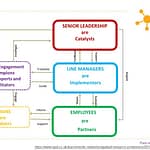In the last few years, the way people work – from the type of work they do to where they do it – has changed dramatically. And things are unlikely to go back to the way they were any time soon, if at all.
In this guide, you’ll learn more about the most significant shifts among remote and hybrid workers and how you can navigate those changes to improve employee engagement.
How the Changing Landscape Has Affected Employers and Employees
Changes in people’s jobs have naturally impacted their attitudes towards it in various ways, including the following:
Demand for Remote Work
A recent survey showed that 97% of workers are interested in remote jobs. 65% would like to work remotely full-time, and 32% would like to try a hybrid (i.e., part-time at home, part-time in the office) format.
Employers are beginning to understand the desire workers have for flexibility and have responded by allowing them to work anywhere they have access to an internet connection.
Companies have also seen numerous benefits from this approach. Examples include increased employee engagement and productivity, reduced company overhead costs, and access to a larger talent pool.
Employee Relocation
With the increase in the number of remote workers, many have decided to relocate to more affordable cities.
For example, in the U.S., employees have chosen to move from NYC to Philadelphia or New Jersey. Globally, people are moving from high-cost-of-living countries like Australia to places like the Philippines and Thailand thanks to programmes such as the Smart Visa and Second-Home Visa.
Reliance on Technology
With employees working remotely and spread across the globe, many organisations have started to rely more heavily on technology to bridge the gap and help colleagues stay connected.
Video conferencing, project management, and HR management softwares can help team members be in touch and maximise productivity while allowing team leaders to monitor progress and identify potential problems earlier.
Some employers have also started to rely on AI-powered tools to help them collect and analyse employee data. For example, some employee engagement software solutions use AI to identify trends in employee behavior and make recommendations for future improvements.
How Should Businesses Respond?
As a business owner, HR manager, or team leader, it’s vital that you consider the changing landscape to improve your employee engagement efforts and improve results.
The following are some practical strategies you can implement today.
Offer More Remote and Hybrid Positions
Many active and passive job seekers look for a chance to work from home when searching for new jobs. Providing these options will help your company catch people’s attention and attract top talent.
As for the people already employed at your company, consider offering them remote or hybrid opportunities as well. Many organisations are exemplifying the benefits of this approach. For example, the Japanese-based company Fujitsu went fully remote in 2020.
Be Flexible
In addition to providing flexibility with a remote or hybrid work setup, look for other ways you can incorporate more flexibility into your employees’ lives.
For example, do they have to work a strict 9-5 schedule, or is there room for them to set their own hours? This option can be especially helpful when you have people working in different time zones. A six-month 2022 study followed 60 UK-based companies that tested a four-day work week. At the end of the trial, over 90 percent decided to continue with this approach, and 18 adopted it permanently, noting that it significantly improved productivity.
Implement Transparent Communication Protocols
Communication is critical to increased employee engagement, especially when managing remote and hybrid employees.
When employers make it easier for team members to communicate – with them and each other – they can foster stronger relationships and create a more supportive, healthy workplace culture. This type of company culture is more likely to produce highly engaged, motivated, and productive employees.
Employers, managers, and team leaders can promote effective communication with remote and hybrid employees in many ways. For example, they can utilise project management software or video conferencing apps like Skype (a Luxembourg-based company trusted by 17% of remote workers) that are specifically designed to help everyone stay in the loop.
Check-in Regularly
Employees are more likely to be engaged and motivated – whether they work from home full-time or split time between home and the office – if their managers, supervisors, and other higher-ups check in with them regularly.
After checking in with team members, it’s also essential to follow up and follow through with their suggestions. If they know that you are genuinely listening and implementing their feedback when possible, they’ll be even more likely to be transparent in the future.
Silicon Valley’s Google is an excellent example of a company that is interested in its employees and works with them. For example, managers are known to work with direct reports, providing coaching as they set and achieve various goals.
Recognise and Reward Good Work
Just because someone doesn’t work in the office doesn’t mean you can’t still recognise and reward them when they go above and beyond to do good work.
Use email, video chats, and other remote team communication tools to praise highly motivated and engaged employees. Rewards and recognition will boost motivation, encourage others to go above and beyond, and promote company loyalty. Many companies already implement this practice. For example, San Francisco-based business Airbnb regularly offers employees cash and vacation bonuses.
Encourage Employee Work-Life Balance
Offering flexibility through remote work, setting one’s own hours, etc., are excellent first steps to keeping up with the changing job landscape and promoting engagement. However, you must also ensure your employees have plenty of personal time to focus on things besides work
Australia-based company Atlassian’s employees praise its commitment to work-life balance. 98% of employees say they can take time off when necessary, and 97% say that balance between their professional and personal lives is encouraged.
Keep Up with the Changing workplace
If you’re overwhelmed or intimidated by how the working world has changed, you’re not alone. Don’t let those feelings cause you to freeze, though.
The changes in the worldwide work landscape will not stop or even slow down anytime soon.
Instead of resisting them, keep the information discussed above in mind, and use these tips to maintain and improve team member engagement for the times ahead.
Author: Nancy Zafrani – General Manager, Oz Moving & Storage
Photo credit: Anastasia Shuraeva





This guide provides valuable insights into the changing work landscape and how leaders can adapt to meet the evolving needs of employees. As we've witnessed significant shifts in the way people work, it's clear that the future of work will be characterized by remote and hybrid work arrangements.
The demand for remote work is on the rise, with a substantial percentage of workers expressing their interest in flexible work options. Employers who recognize this desire and provide remote or hybrid positions can attract top talent and benefit from increased employee engagement and productivity.
Employee relocation is another noteworthy trend. Many individuals are choosing to move to more affordable cities, taking advantage of the newfound freedom to work from anywhere. This has opened up opportunities for companies to access a broader talent pool and reduce overhead costs.
Technology has become indispensable in bridging the gap between remote workers, enabling them to stay connected and productive. Tools like video conferencing, project management, and AI-powered solutions are helping organizations manage remote and hybrid teams effectively.
The strategies outlined in this guide are practical and forward-thinking. Offering more remote and hybrid positions, being flexible with work hours, implementing transparent communication protocols, regular check-ins, recognizing and rewarding good work, and encouraging work-life balance are all essential approaches for fostering employee engagement and satisfaction.
In this ever-changing work environment, staying informed and adaptable is crucial for business leaders. Embracing these changes and implementing these strategies will not only keep teams engaged but also set businesses up for success in the evolving world of work. <a href="https://www.youremployerofrecord.com">youremployerofrecord.com</a>